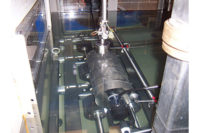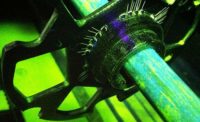Choose the Right Equipment for Magnetic Particle Inspection
Eight steps to consider in choosing the right system for your inspection.






Since its origin in the late 19th century when a magnetic compass was used to detect defects in magnetized cannon barrels, the selection of the right magnetic particle inspection system could be challenging. With the implementation of magnetic particles in the 1920s, the means to locate discontinuities greatly improved.
This article will give you the criteria to use in choosing the right system for your inspection. First, the part has to have magnetic properties (ferromagnetic) to be tested by magnetic particle inspection.
The following are the steps you should use in choosing the right equipment.
1. Part size, weight and geometry
In most cases, you will have a drawing of the part you will inspect. This will give you the size, weight and the geometry of the part to be inspected. It could also identify the industrial specification which provides the type of inspection required for the part. If a drawing is not available you will of course need a sample of the part that will be tested to determine the best method to inspect the part.
The size and weight of the part determines if the operator can place the part into the machine by hand or if special material handling is required. Some parts may weigh hundreds to thousands of pounds and may be too large to be put on a machine. The need for a crane, forklift or some other lifting device to move the part may be necessary. You may need a custom fixture or mobile power pack to magnetize parts such as large valve bodies.
The geometry of the part determines the type of equipment and process you will need. For example, an automotive steering knuckle by design has protrusions sticking out and difficult places to generate a proper field for the inspection. This will require a special fixture and multiple mag shots.
2. Type of current required to find the discontinuity type (surface or subsurface)
For this determination you can reference the appropriate specification for inspecting the part. Also determine if you are inspecting a manufactured/processed part (OEM) or a service part. Let’s use a crankshaft as an example. To inspect a crankshaft at the point of manufacturing, finding subsurface indications is most important. The best means to accomplish this is to use DC (direct current). For overhaul shops inspecting crankshafts finding surface indications with AC (alternating current) is critical since stress cracks start at the surface while in service.
3. Volume of parts to be inspected
With smaller parts you may be concerned with production rates or whether or not the part will be inspected manually or by automation. A common mistake made in determining a production rate is to omit the time an inspector takes to inspect the part. A unit can be designed to process at a given rate but the number of inspectors needed to match the process rate must be determined. Obviously if the process rate is higher than the inspection rate you will have a bottleneck in your inspection department.
4. Strength and direction of the magnetic field
It is important in magnetic particle inspection to ensure the adequacy of existing fields and their direction to be adequate in relation to the size and direction of the discontinuity so that a good indication can be produced at field leakage points. Using too much current in the creation of a proper magnetic field could create too much background thus masking an indication or damage parts due to arcing. It is recommended to start low and slowly increase power to meet the requirement for inspection. To help you determine the correct field strength and direction there are a variety of test pieces you can use such as QQI’s (Quantitative Quality Indicator) Pie Gauge, actual parts with known discontinuities, or using formulas to determine proper field strength.
5. Budget available
Like any purchase, the budget available to you must be considered in choosing the type of equipment you will require. Though you can purchase equipment to perform magnetic particle inspection for less than $1,000 such as a yoke, your application may require a unit that costs in the tens of thousands of dollars range. This may require you to create a justification document for your facility to move forward.
6. Personnel dedicated to the inspection process
Personnel consideration goes back to the inspection rate and budget available. There is an ongoing budget after the purchase of the equipment such as installation and training. Another requirement that is sometimes overlooked is the ongoing maintenance and upkeep of the equipment. Mag benches are very durable but if not maintained properly the lifespan will be significantly decreased.If proper preventative maintenance such as calibration checks, cleaning of the tank and the bath are not changed on a scheduled basis there will be an increase in failed pumps, hoses and other mechanical components.
7. Requirement for demagnetization
There are several reasons to demagnetize an inspected part: if the part is to be plated or painted, if the part will be a moving part, subsequently machined or electric welded or residual magnetic field will affect instruments sensitive to magnetic fields, i.e. aircraft parts. This goes back to the part size, weight and geometry. You can demagnetize a part using the magnetic particle equipment but for higher production rates the demagnetizing process may be accomplished using a separate demagnetizing coil that can be integrated into the inspection system.
8. Other considerations
You should consider the electrical limitations of the facility in which the equipment will be used. Like any industrial piece of equipment, safety concerns pertaining to your facility should be addressed since there are dangers associated with the usage of magnetic particle inspection equipment. What type of inspection booth/hood will be required, or will the unit be placed in a darkened room?
In summary, the selection of the right equipment that will meet your requirement for magnetic particle inspection involves a step by step evaluation. The characteristics of the part, the type of discontinuity and available budget must all be taken into consideration when selecting the best fit of an inspection system.
Looking for a reprint of this article?
From high-res PDFs to custom plaques, order your copy today!







